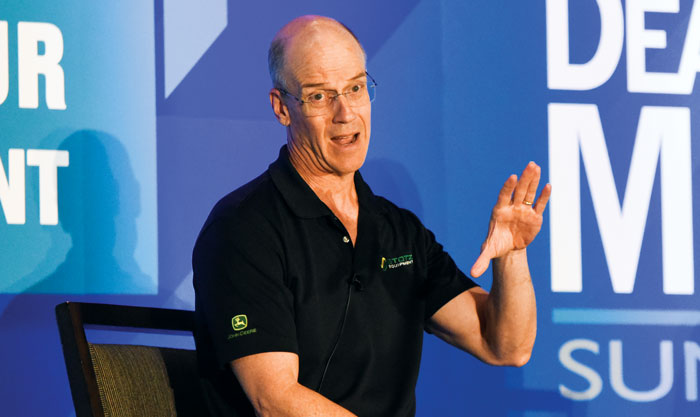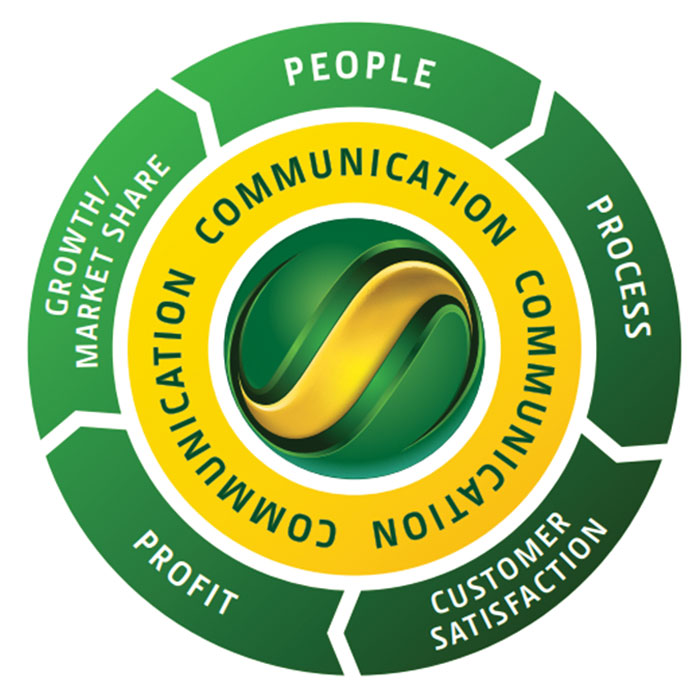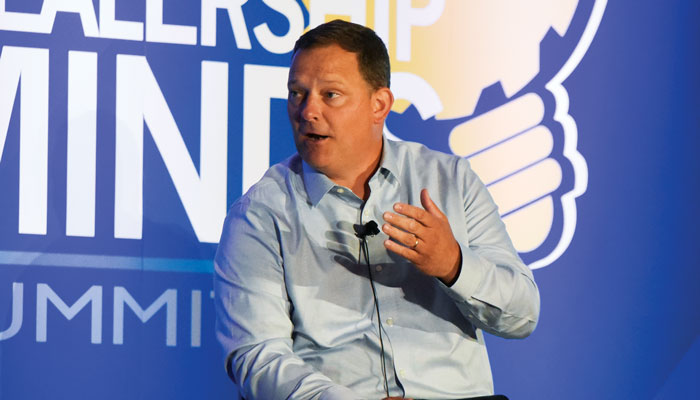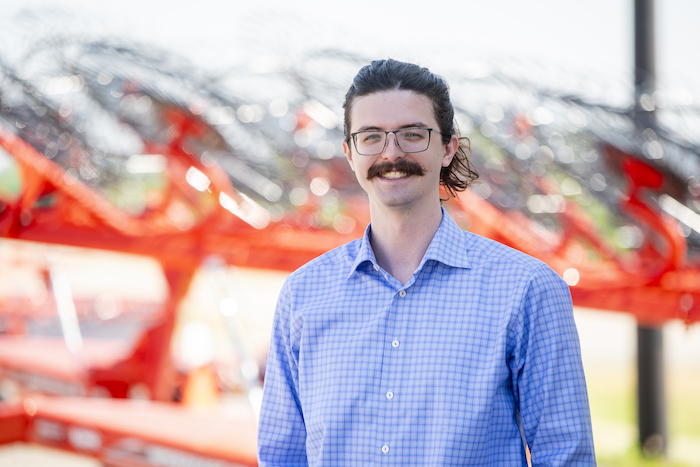Creating your dealership’s next generation of leaders can be a daunting task, regardless of your resources. Coupled with the ongoing labor shortage, it’s more important than ever to keep and grow your key staff into capable and confident leaders.
Stotz Equipment President Tom Rosztoczy of Stotz Equipment sat down in a recent dealer panel to discuss how their organization built their own leadership development program and what successes they’ve seen.
Acquisitions Require Leaders
Rosztoczy explains that the origin of Stotz Equipment’s leadership program, titled “Aspiring Leaders,” came out of a series of acquisitions that left them needing managers.
“Back in 2009 we had 12 locations in 8 western states,” he says. “In 2010, we got a chance to buy a 2-store dealership in Wyoming. As we were going through that process, someone on our leadership team asked, ‘Do we have the people it’s going to take to run these new stores?’ So I got out a whiteboard, and we brainstormed. We decided we had someone within our organization we thought could run the two new locations. And we had someone in our organization who could take his place and someone who could take their place.
“Unfortunately from a depth perspective, a year later we bought 7 more stores. They had 5 key leaders, and 4 of them left in the transition. So we went from having great depth as a 12-store dealership to having no depth and really being way too thin leadership-wise as a 21-store dealership.”
Dealer Takeaways
- Don’t wait until you need leaders. Coach them now for future roles.
- Consider using required reading to teach your potential leaders.
- Encourage potential leaders to set their own development goals.
- Start small and find staff passionate about development to help lead the program.
- Make sure executives carve out time to train new leaders.
Assuming each of the department managers of their now 21 stores stayed for an average of 10 years, Stotz now had to develop 7-10 leaders every year.
“I didn’t think at 21 stores we were finished,” he adds. “Not only did we need to catch up and then grow enough of our own replacements, but we had to grow extras so if we had another chance to buy more stores, we had the extra leaders to put in place there.”

Tom Rosztoczy, president of 25-store John Deere dealership Stotz Equipment, believes employees relate better to leadership training when it comes from executives at the company.
Stotz Equipment’s answer was two-fold: begin hiring employees based on their potential as a future leader and build an official leadership training program.
Stotz’ program for training leaders is built off their circle of core values: people, process, customer satisfaction, profit and growth.

Stotz Equipment’s 5 core values inspired the similar structure of their “Aspiring Leaders” program, running through the same 5 values in addition to communication and an intro “Aspiring Leaders” class.
“Our circle starts with people up at the top. If you want to be best in the world at something, you’ve got to have great people on the team,” he says. “Those people need processes or systems for how we go about doing business. Great people, great processes drive customer satisfaction. Customer satisfaction drives profitability. And then profitability drives growth. We make money, then we reinvest in the business and grow.
“Growth brings it full circle because as we grow and need more people, the quality of those people becomes more important. And for us, communication acts like the hub of the wheel. If we communicate effectively, then everything works like it’s supposed to and we keep getting better and better.”
Rosztoczy says using the structure of their core values inspired the 7 classes in their “Aspiring Leaders” program, which begins with a class to help future leaders understand themselves before they dive into the full circle of values.
“The first class is just called Aspiring Leaders,” says Rosztoczy. “My own personal perspective is, to be an effective leader, first you have to be an effective person and comfortable with yourself. That’s what the first class is about, just getting comfortable with yourself, understanding yourself.”
Using Books & Tests to Coach Aspiring Leaders
Stotz’s program takes on a new group of “students” every November, with the goal of completing all 7 classes in 2 years. Each of the 7 classes takes place over the course of 2 days, with a book assigned to the group beforehand as required reading (see “Aspiring Leaders Required Reading List”).
“I’m a big believer in table discussion during the classes,” adds Rosztoczy. “In our first Aspiring Leaders class, Seven Habits is the book we use. I might talk about something for 10 minutes, and then I’ll have a couple questions for the people at the tables to discuss amongst themselves.
Aspiring Leaders Required Reading List
Aspiring Leaders (November)
- 7 Habits
People Class (February)
- First, Break All the Rules
- 5 Dysfunctions of a Team
- Crucial Conversations
Process Class (July)
- Who Moved My Cheese?
- One Minute Manager
- Leading Change
Customer Class (November)
- Satisfaction
Financial Class (February)
- Financial Intelligence
Growth Class (July)
- Customers for Life
Communication Class (November)
- Crucial Conversations (second reading)
- Good to Great
“Because we put so much emphasis on the table discussion, we’re very intentional about how the tables are set up. The assigned seating is intentionally meant to bring as much diversity as possible to every table. So people from service, parts, sales, admin, people from Idaho, Utah, California, Arizona are mixed together to create as much diversity as possible at every table.”
Rosztoczy adds that one of the books, Crucial Conversations, is required reading for staff in both the first and the last class, in order to compare their answers to the book’s Style Under Stress test over 2 years.
“The test gives you an indication of how effectively you naturally deal with crucial conversations, which are controversial, emotional and important conversations,” he says. “We all have these natural tendencies for how we deal with those. Some of us are naturally good at it, and some of us are not.
“In the first class, they take the Style Under Stress test and talk at their table amongst themselves about their results. And then they hand in their results to me. And then a year and a half later when they have the communication class, they take the Style Under Stress test again, and I pass out their results from a year and a half ago, and we see how they compare. The very first time I had a group go through it, I had a number of people whose results had gotten better.”
“I think it’s important to recognize that learning is something that you engage in; it’s not something that happens to you…” – Tom Rosztoczy, Stotz Equipment
Rosztoczy adds that while he initially taught all the classes, Stotz Equipment’s CFO and other executives have stepped in to teach.
“We found the people in the classes really appreciate getting to hear from and talk to someone who’s actually done it in real life,” he says. “In the Process class as an example, I’ve got a parts manager who comes in and talks about how he got the processes working properly in his parts department, and I’ve got a service manager who does the same thing for the service department.”
The classes require staff to construct personal goals for themselves and share them with the group, as well as give updates over time on how they’re reaching them. For the first class in particular, staff are also required to take a Profile XT personality test beforehand and write a short bio to share with the group.
“At the beginning, we start with introductions and icebreakers. We typically would have 30-35 people from across the company who don’t know each other coming together for that class, so they’ve got to get to know each other,” says Rosztoczy. “That first class we spend a lot of time on company history and company philosophy. I’m the third generation in our business. My mom is still around and still very active, so she comes for about an hour and people just get a chance to meet her and ask her questions, which they love.
What If I Don’t Have Time as an Executive to Coach Potential Leaders?
Mike Burnett, learning & development manager at Empire Southwest, an AGCO and Caterpillar dealer based out of Arizona with 7 ag locations, addresses the worry that executives won’t have the space in their schedule to coach up-and-coming leaders by reminding them that it’s their job to grow their team.
“In our leadership program, a big message that we focus on is, ‘Your number one responsibility as a leader is to develop your team,’” he says. “Yes, you need to meet budget, meet deadlines, but your number one responsibility is to build up and develop your team.
“I think at most companies, when times get tough, two things typically go away: marketing and training. But we actually have a dedicated training institute building just for learning. We’ve got about 8 different classrooms, and we’re very fortunate to have it.”
“We go over the Profile XT results. As I mentioned, this class is really about just getting to know yourself, so that Profile XT helps make you understand how you tick. In every class, we try to give people an opportunity to have experiences that will help prepare them for a management role if they’re not currently in one. In this class, we talk about being a mentor. I really believe if you’re not a manager today but you want to be one, trying to mentor others is a great opportunity for you to learn about that.”
For the first class, Stotz Equipment often brings in their General Service Manager Julie Jackson. Rosztoczy considers her one of the program’s first success stories, as someone who held non-management roles for 15 years and became a service manager after just one year in the program.
Breaking Down Program Success
Stotz Equipment began its Aspiring Leaders program in 2012 and has moved over 200 employees through the program, more than 40% of its staff. While Rosztoczy keeps expecting the program to “run its course,” every year sees another 30-35 staff signed up for the program.
“If your employees are involved in setting their goals, they’re going to take those goals more seriously and really strive to achieve them…” – Aaron Koenig, Koenig Equipment
“In the past 3 years, we’ve tracked how many management roles we fill internally vs. hiring somebody from the outside. We filled 75% of our management roles internally in the last 3 years, which I would consider very successful. A big part of that is this program we’ve got,” says Rosztoczy. “There’s one surprise benefit that we’ve been really happy with and that’s been the cultural benefit for our entire company. We found the classes stem from the things that were formative to me in how I think about running a business. I tell people when they graduate that we expect them to be flag bearers for the culture of Stotz Equipment because now they not only understand what we do and the reasons why we do things the way we do, but they’ve read the books that form the foundation of how we think about business.”
Rosztoczy also adds that he finds employees who go through the program but don’t end up in a manager position are able to still be leaders on their teams without a title. “Within our company, and especially if you’ve gone through our program, I expect you to function as a leader even if you don’t have the title of manager,” he says.
The Aspiring Leaders program has improved the dealership’s public image through word-of-mouth from graduates of the program, which he says has only helped bring more quality employees into the company. One unexpected addition to the company has been Stotz’ ability to hire MBAs, people who Rosztoczy thought would never be attracted to the farm equipment dealership business.
“Somebody suggested we should be hiring MBAs, people coming out of good business schools,” he says. “And I though there’s no way, we’re just a John Deere dealer, we’d never be attractive to people like that. But we tried it, and we’ve been stunned. In the last year, we’ve hired 3 recent MBA grads, and they are bright and talented, exciting to work with.”
Tips for Smaller Dealerships
Recognizing that not all the examples and tools recommended will fit every dealership model, Rosztoczy recommends smaller dealers with fewer employees begin a formal book club in place of a 2-year program and offer a single book to employees for the company to study together.

President & CEO of Koenig Equipment, a 15-store John Deere dealership, Aaron Koenig says smaller dealerships should start small with their programs. Go to Farm-Equipment.com/1021 to read about Koenig equipment’s 3-step apporach to training leaders.
“I think it’s important to recognize that learning is something that you engage in; it’s not something that happens to you,” he says. “So if you’ve got any sort of structure at all, employee development should be part of that. Unless you’re a one-person organization, there’s an opportunity for development, and you have to find time to prioritize it, simple as that.”
Aaron Koenig, president & CEO of 15-store John Deere dealership Koenig Equipment, says their own leadership training program, Koenig University, started small with just himself and one instructor, and he believes all programs should start small in the beginning.
“We’ve also done what’s called ‘structured on the job training,’ which are 5-30 minute topics with an in-house expert teaching on your behalf vs. you feeling like you have to do everything,” Koenig says.
“I would also focus on themes to begin with, certain parts you want to roll out, so you don’t have to have a huge program and initiative that might get overwhelming. You’ll find the people who are embracing it, leverage them and get them to be those ambassadors with you that can help grow the program together.”
3 Steps for Developing Leadership Potential in Your Dealership
Aaron Koenig, president & CEO of Koenig Equipment, a 15-store John Deere dealership with stores in Ohio and Indiana, explains the 3 steps his dealership uses to turn employees into future leaders.
1. Identify the Talent — Koenig says one way Koenig Equipment hones in on employees who that are good potential leaders is with a “nine-box grid.”
“The grid measures potential on one axis and performance on another,” he says. “So we sit down as managers and just talk through the people in our dealership and look for people who are generally speaking to the right of that grid, who’s got some combination of potential and performance.
“The other thing we do is encourage employee recognition as a standard agenda item at our meetings, and we’re calling out people maybe who haven’t sold the most but those who reflect our core values and people we want to duplicate or emulate.”
Koenig also recommends dealers implement a formal performance management system to track employees’ performances. He also recommends dealers allow employees to make notes and contribute to their reports in system as opposed to a solely “top-down” approach to performance tracking.
2. Develop the Talent — Koenig Equipment assigns mentors to help develop potential leaders in the company, in addition to the custom development plans each employee has in the company’s performance management system. Potential leaders are then enrolled in Koenig University, Koenig Equipment’s homegrown leadership development program that is taught almost exclusively by leaders within the company.
“The curriculum is largely taught by leaders within the organization,” says Koenig. “That’s our default. If we need help then we bring help in from the outside, but we feel like the employees relate better if they see someone in the organization actively teaching the coursework.”
Koenig stresses that one of his key takeaways from the Koenig University program is the importance of having employees participant in their goal setting.
“You’re going to set bars for them to clear, but in general if your employees are involved in setting their goals, they’re going to take those goals more seriously and really strive to achieve them,” he says. “I don’t believe it’s my primary responsibility as leadership to report on their progress. I want our employees to report to me on their progress, including what their challenges are. And then as a servant leader, I ask how I can help them overcome those obstacles.”
3. Engage Your Leaders in Training — Koenig Equipment offers several ways to engage it’s potential leaders, with one key method being the status of “subject matter expert.”
“They can be a subject matter expert on product, process and systems. There are other things, but those are the 3 that we have the most engagement with,” Koenig says. “As a salesperson, for example, I can be a combine specialist. I’m actually teaching other salespeople what they need to know about combines. A systems specialist is for people who get excited about knowing the business system or even Deere systems, and they enjoy teaching others.”
Another key facet when it comes to engaging leaders in training is peer coaching and project leadership, where employees can learn to not only help each other but exercise leadership skills.
“As they become more experienced, enrolled employees progress from a participant to a lead and then eventually to what we call a champion,” he says. “People really get energized around the opportunity to identify and solve a problem that the dealership has.
“A third item for engagement is what we call engagement teams. We do an annual engagement survey with our employees, and that helps us identify areas of improvement. And then we form engagement teams whose job it is to help us work through those problems, and then cascade it throughout the dealership.”
Koenig adds that it’s important for management to talk to employees about what type of engagement they prefer, in the same way that some staff may prefer different forms of recognition (e.g. getting the spotlight in a team meeting vs. a private congratulations).
Facing Reality: Dealers Must Develop Their Own Home-Grown Talent
Why Executives Should Train the Next Generation of Leader
Developing Leaders Takes Time but Yields Big Results
How to Identify, Develop & Retain Your Dealership’s Next Generation of Leaders
Leadership Development Must Be Proactive
College Recruitment Programs Help Alleviate Hiring Crunch








Post a comment
Report Abusive Comment